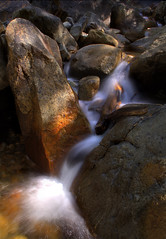Distorted Boxes - Cesky Krumlov (Spring 2003)

Several years ago, I read about an architect who designs buildings without any straight lines whatsoever. I think he's fairly famous, so you may have heard of him. His reasoning was "straight lines don't occur in nature." I suppose if one wishes to gain recognition in the field of architecture, one must have a gimmick of some sort, and this was his.
That was the first time I had considered the concept of shapes that do or do not occur in nature, and naturally I wanted to prove wrong the statement that straight lines do not occur there. I began thinking of things that resembled lines: grass stems, tree trunks, swordfish beaks, etc. But, all these things have at least some curvilinear shape, even if minimal.
Finally, crystalline structures saved the day. Any edge of a crystal, where two perfectly flat surfaces meet, must run in a straight line. Large quartz crystals are an easy example to use. So, lines do occur in nature, even if only on rare occasions.
Boxes too, while even more uncommon, do occur in nature. Crystalline structures again come to the rescue. Pyrite, sodium chloride, and a number of other crystals appear in perfect cubes or other box-like shapes.
Still, the civilized world, especially western civilization, does seem to use the box excessively. I think we've been relegated to its use due to our choice of construction materials and techniques. For example, I can't imagine how difficult it would have been for the ancient egyptians to have built a pyramid out of pyramidic building blocks. It was much easier to stack a bunch of cubic boxes on top of each other to form the final shape.
Our primary use of the box as the final shape, rather than the pyramid or any other shape, probably comes down to population growth. As the demands of a larger population increase, the need for efficiency also increases. Boxes have proven to be the most efficient shape for our use in so many contexts that it's hard to get away from them in modern society. Even our roads run in box-like grids where possible. It's even annoying when they don't, as is the case in the city of Colorado Springs, where there is no rhyme or reason to the layout of the roadways.
And then, of course, we have the tendency to put people in boxes. Some of them, I'll admit, should be put there and never allowed to leave, as in the case of prison. But then, there are those mental boxes in which we are prone to unfairly place people. "She was mean to me once, therefore she is a mean person." "He lied about that, therefore he is a dishonest person." These boxes of judgement, while sometimes justified, are often misused, causing us to decide that various people are or are not worth our time based on too little information to come to such an enormous conclusion. As a result, we often forget that everybody has at least some individual merit.
So, yes, boxes occur in nature, but they can be hard to find, so it seems that nature doesn't favor them. In fact, as you can see in the photo above, nature often likes to make our boxes a little less boxy. Perhaps there's a lesson to be learned in this, as I am inclined to think there always is.




1 Comments:
yes, i've wondered what it would be like for a primitive bush-man, for example, to visit a city for the first time... particularly what it would feel like to live in a box for the first time.. to see all those razor-sharp lines, and perfect corners. maybe it would be like us visiting the "crazy-house" at the carnival.
Post a Comment
<< Home